
Short winter days are now upon us. Usually, we don’t consider the actual length of our day to be shortened, otherwise we could leave work at 3:00pm! There may be less daylight now, but the measure of the day does not change throughout the year. Why is this? The transition between seasons often makes us more aware of time and the ways we choose to apportion time during the day. Why do we structure our days around dates and increments instead of around feasts and labor? How were days and hours understood in the medieval period? Was time measured differently during the Middle Ages in comparison to contemporary, “equal” time standards? To answer these questions, today we will travel back in time to explore the history of calendars and some special illuminations of calendar pages from The Hours of Le Goux de La Berchère.
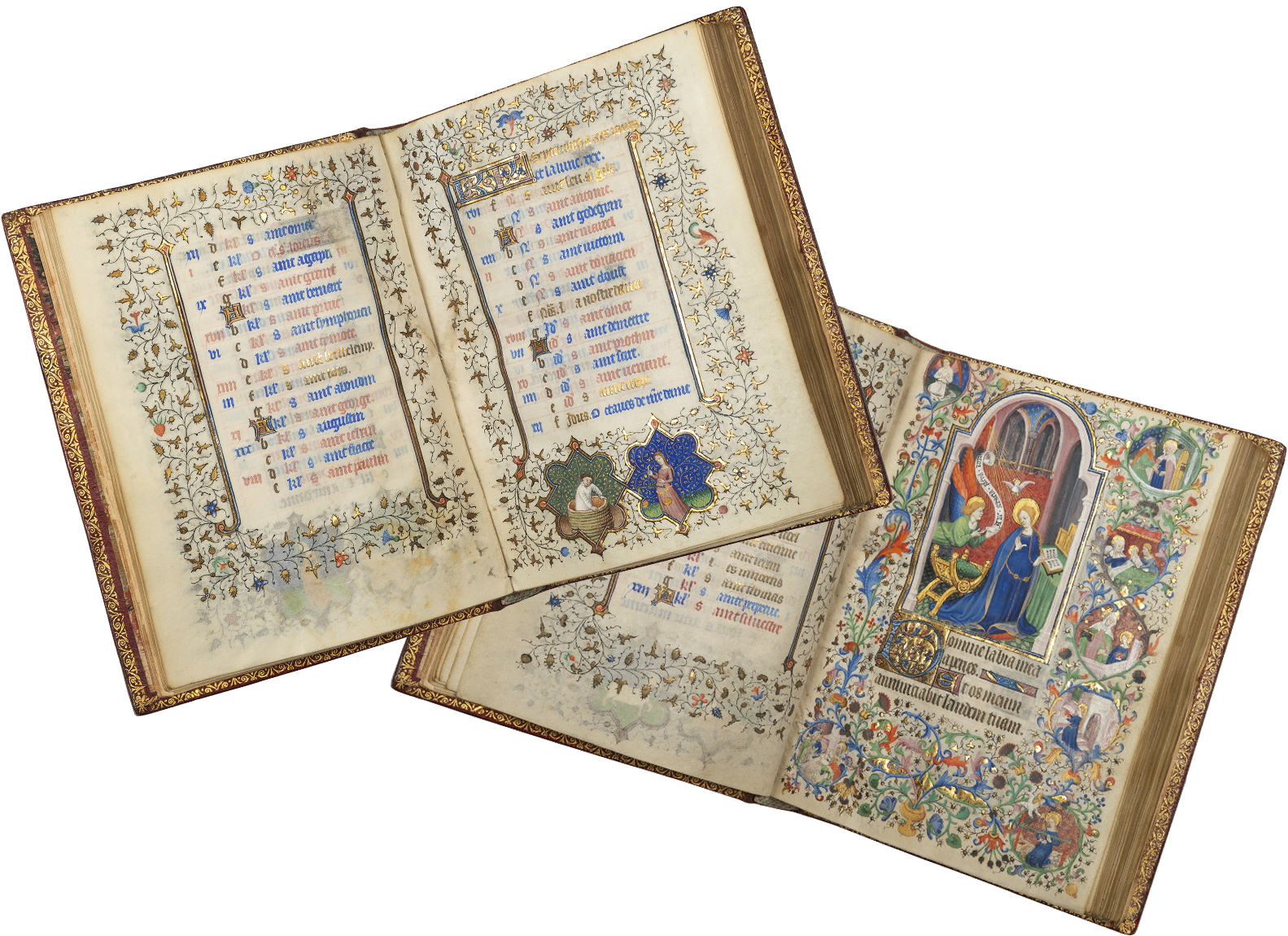
Les Enluminures, BOH 213, The Hours of Le Goux de La Berchère (Use of Paris), France, Paris, c. 1420.
With the return to standard time from hot summer daylight savings time here in New York and especially with the ongoing debates about abolishing daylight savings, I’ve found myself thinking about time quite often over the last few weeks. One of the main types of manuscripts we have at Les Enluminures is the book of hours, and Books of hours are all about time. The way that we understand and perceive time today as a measurable and objective quantity is very different from the medieval understanding of time. Time as a measurement has always been a socially constructed concept. We understand time in seconds, minutes, and hours based on an invented system that was used and understood quite differently in the Middle Ages, although there are many overlapping similarities between medieval and contemporary time.
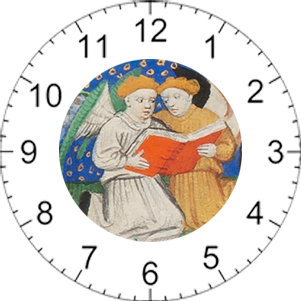
Time was a cyclical phenomenon to medieval people, experienced and measured in very different ways than we experience time today. Gothic art was deeply impacted by the medieval experience of time and, by extension, by the understanding of sacred history as characterized by a cyclical, ritualistic understanding of time as an eternal return to a perfect eden of past. Ritual was another important aspect that structured time and the use of medieval peoples’ days. Labor and even religious ritual shifted with the seasons. However, we, or at least I, tend to imagine time as a linear line, with a fixed beginning and ending. Bearing this in mind you might now be wondering, when did our understanding of time shift from cyclical to linear, and why?
Time was understood through a few different mediums in the medieval period. First, day and night, cyclical events, structured the medieval person’s experience of day-to-day life. Ritual also aided in this, as prayers were said at certain parts of the day. For those who could not entirely structure their days through prayer, labor played a key role in informing the ritualistic counting of time. Labor also changed throughout the year depending on the seasons. We will come back to this as we discuss the calendar and zodiac signs shortly. For example, the “hour” indicated by the book of hours was not the measured hour as we understand it today. An hour is a unit of time conventionally understood as 1/24 of a day. This unit is scientifically reckoned as about 3,600 seconds. There are 60 minutes in an hour, and 24 hours in the day as we understand it in the present. The hour was initially established in the ancient Near East as a variable measure of 1/12 of the night or daytime. Thus, the hours in the past were dependent on variables of the earth and thus were known as seasonal, temporal, or unequal hours as their duration was affected by season and latitude.
In our system of measuring hours today, hours are known as Equal or equinoctial hours. They were taken as 1/24 of the day as measured from noon to noon; the minor seasonal variations of the unequal hour were eventually smoothed by making it 1/24 of the mean solar day. Since this unit was not constant due to long term variations in the Earth's rotation, the hour was finally separated from the Earth's rotation and defined in terms of the atomic or physical second.
Many different ways of counting the hours have been used throughout history. Because sunrise, sunset, and, to a lesser extent, noon, are the conspicuous points in the day, starting to count at these times was, for most people in most early societies, much easier than starting at midnight. Astrolabes, sundials, and astronomical clocks sometimes show the hour length and count using some of these older definitions and counting methods. For ancient and medieval peoples, the counting of hours generally started with sunrise. Before the widespread use of artificial light, societies were more concerned with the division between night and day, and daily routines often began when light was sufficient.

The idea of "Babylonian hours" divide the day and night into 24 equal hours, reckoned from the time of sunrise. They are so named from the false belief of ancient authors that the Babylonians divided the day into 24 parts, beginning at sunrise. In fact, they divided the day into 12 parts (called kaspu or "double hours"). As you can see, in the past time was generally not counted out equally in an empirical sense.
In ancient and medieval cultures, the counting of hours generally started with sunrise. Before the widespread use of artificial light, societies were more concerned with the division between night and day, and daily routines often began when light was sufficient. Sunrise marked the beginning of the first hour, the middle of the day was at the end of the sixth hour and sunset at the end of the twelfth hour. This meant that the duration of hours varied with the season. In the Northern hemisphere, particularly in the more northerly latitudes, summer daytime hours were longer than winter daytime hours, each being one twelfth of the time between sunrise and sunset. These variable-length hours were variously known as temporal, unequal, or seasonal hours and were in use until the appearance of the mechanical clock, which furthered the adoption of equal length hours. This is also the system used in Jewish law and frequently called "Talmudic hour" (Sha'a Zemanit) in a variety of texts. The Talmudic hour is one twelfth of time elapsed from sunrise to sunset, day hours therefore being longer than night hours in the summer and the reverse in winter.
In "Italian time" the first hour started with the sunset Angelus bell (or at the end of dusk). The hours were numbered from 1 to 24. For example, in Lugano, the sun rose in December during the 14th hour and noon was during the 19th hour; in June the sun rose during the 7th hour and noon was in the 15th hour. Sunset was always at the end of the 24th hour. The clocks in church towers struck only from 1 to 12, thus only during night or early morning hours. This manner of counting hours had the advantage that everyone could easily know how much time they had to finish their day's work without artificial light. It was already widely used in Italy by the 14th century and lasted until the mid-18th century and was officially abolished in 1755.

The Angelus (1857–1859) by Jean-François Millet (detail)
The system of Italian hours can be seen on a number of clocks in Europe, where the dial is numbered from 1 to 24 in either Roman or Arabic numerals. The St Mark's Clock in Venice, and the Orloj in Prague are famous examples. It was also used in Poland and Bohemia until the 17th century
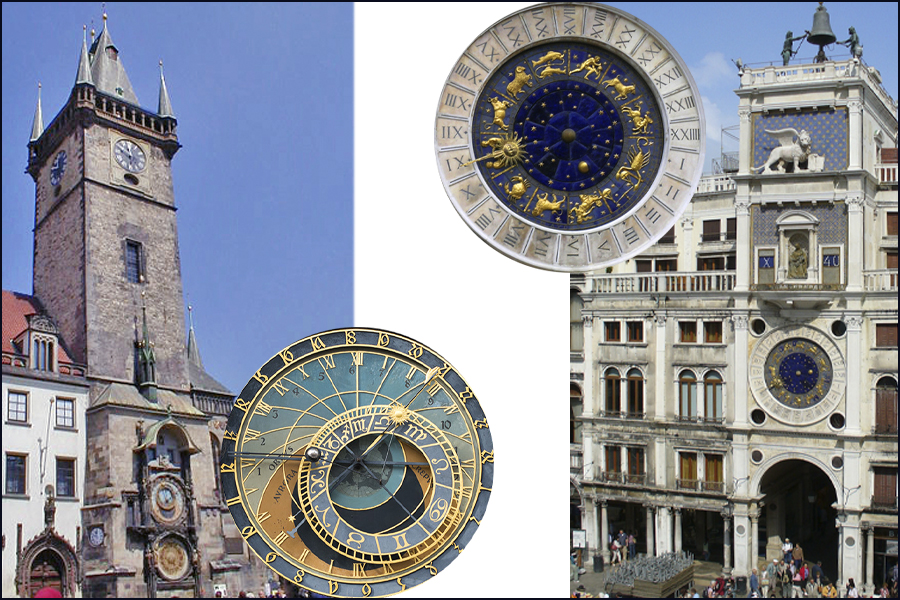
Another example of the social flexibility of time counting and hours is seen in the Islamic day, which begins at sunset. The first prayer of the day (the maghrib) is to be performed between just after sunset and the end of twilight. Until 1968 Saudi Arabia used the system of counting 24 equal hours with the first hour starting at sunset.
Medieval astronomers such as al-Biruni and Sacrobosco, divided the hour into 60 minutes, each of 60 seconds. However, Roman hours continued to be marked on sundials in medieval Europe. Even more important than Roman hours however, were the units of time known as the canonical hours of the Orthodox and Catholic Church. During daylight, these followed the pattern set by the three-hour bells of the Roman markets, which were succeeded by the bells of local churches. They rang prime at about 6 am, terce at about 9 am, sext at noon, nones at about 3 pm, and vespers at either 6 pm or sunset. Matins and lauds precede these irregularly in the morning hours; compline follows them irregularly before sleep; and the midnight office follows that. Vatican II ordered the reformation of the hours for the Catholic Church in 1963, although they continue to be observed in the Orthodox churches.
In the Roman Rite, canonical hours are also called offices, since they refer to the official set of prayers of the Church, which is known variously as the officium divinum ("divine service" or "divine duty"), and the opus Dei ("work of God"). However medieval people also understood time through sacred, holy days. Rather than refer to days by their numerical sequence, medieval people understood each day as a day that commemorated an event in the life of Christ or a saint. This religious significance, not the numerical designation, gave each day it’s true meaning.
The calendar is the first section of a book of hours. It lists the 365 feast days of the year, each divided into 12 months. In some books of hours, lesser feast days were written in black ink and the more important ones in red–– hence the expression “red-letter days.” In later and more lavish manuscripts, blue and gold often replace the red for these major feast days. Some calendars also contained designations in the form of a large letter “D” which stood for “Dies egyptiaci” or “dies mali” from which the English adjective “dismal” derives. This letter “D” designated bad luck days, of which there were always two per month. Finally, and most interestingly for us, the calendar of a book of hours also often contained painted illuminated images.
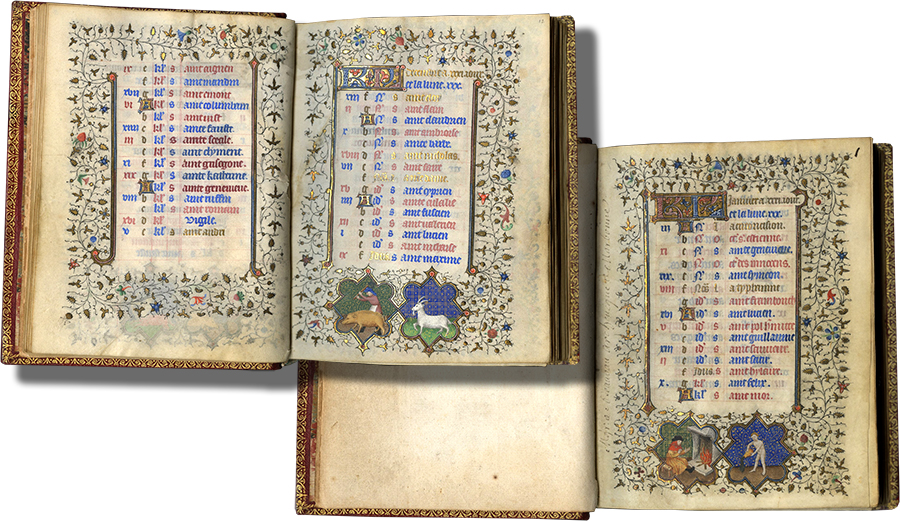
Les Enluminures, BOH 213, The Hours of Le Goux de La Berchère (Use of Paris), France, Paris, c. 1420.
When illuminated, the calendar contained representations of the signs of the zodiac and the labors of the months. Both of these traditions are quite old. The zodiac can be traced to ancient Mesopotamia, and the labors of the moth can be traced to classical antiquity. The calendar miniatures from the Duc de Berry’s manuscript, the Tres Riches Heures, are the most famous of all calendar paintings and are among the best-known paintings from all of the Middle Ages.
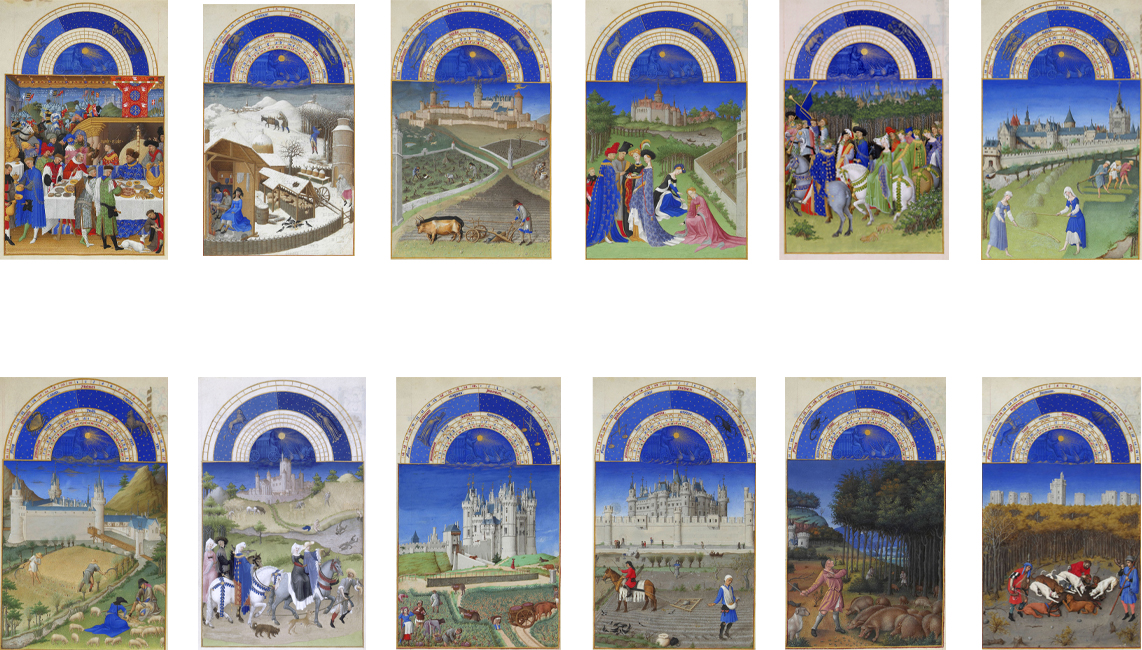
The Très Riches Heures du Duc de Berry, calendar miniatures.
But these full-page illuminations were extremely rare, making it something of an outlier, a mutant, among books of hours. Calendars in the majority of books of hours are not illustrated at all, and those that are usually only have small or half-page miniatures, historiated borders, or vignettes in the margins. Like the many portal entrances to Gothic cathedrals carved with the zodiac and labors of the months, the calendar was concerned with the immediate, the here and now. It was a reference index, and medieval people would generally have found it inappropriate and even obtrusive to have full page miniatures in this section of their book of hours. It was only in the sixteenth century that calendars began to appear in books of hours with large scale painting cycles.
Aside from holidays and feasts, additional information could be gleaned from the calendar. For example, astrological signs of the zodiac were thought to both influence the make-up of a person’s personality and to control specific areas of the human body. For example, Ares governed the head and face, Cancer the breast and stomach. The Zodiac was thus consulted medicinally, and especially for the procedure of bloodletting, or bleeding, since each sign exerted a good, bad, or indifferent influence on this surgical practice.
One of our books of hours has a perfect example of the illuminated calendar. This is BOH 213, The Hours of Le Goux de La Berchère, made in Paris, c. 1420. The text in this manuscript is in Latin and French, and it features 11 full-page miniatures, 24 calendar vignettes, and many, many roundels throughout by the Master of the Munich Golden Legend. The manuscript is in near-perfect condition. It was produced in Paris at the time of the Bedford Master by his chief disciple The Master of the Munich Golden Legend. The Bedford master is thus named for his work for the English court, and his workshop is known for its distinctive narrative roundels that form vignettes in the margins. Our manuscript’s rich palette, sensitive attention to decorative detail, lavish use of gold (including some gold tooling), and creative style and iconography are typical of the earliest Parisian work of the Master of the Munich Golden Legend. Medieval calendar pages look rather complicated to the modern eye. Typically, they are laid out in four columns. In the far right appear the special feasts for each day of the month. These are mostly commemorations of the day the saints were martyred (their “birthdays” into heaven). Other feasts commemorate important events in the lives of Christ and the Virgin. It is common for calendars in French books of hours to be written in easy-to-read French, as occurs here.
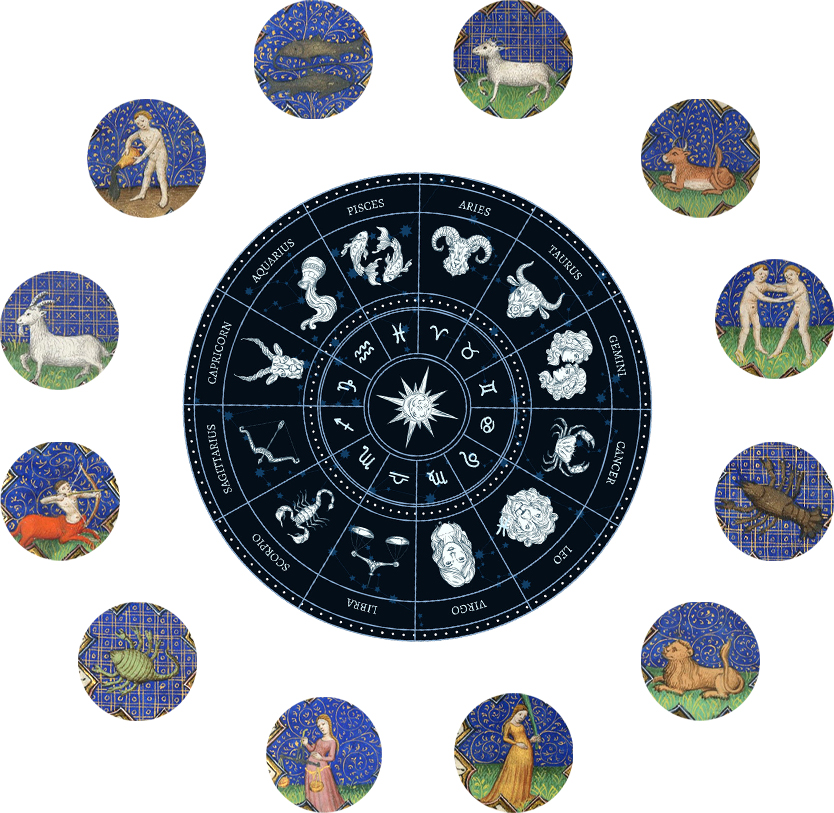
There are twenty-four miniatures in the lower borders of the calendar, depicting the Labors of the Months and the Signs of the Zodiac, in cusped quatrefoil frames, as follow:
f. 1, Jan. Man warming himself by a fire, Aquarius;
f. 2, Feb. Man chopping trees, Pisces;
f. 3 March , Man pruning trees, Aries;
f. 4, April Man carrying a branch, Taurus;
f. 5, May Man on horseback with a falcon, Gemini;
f. 6, June Man cutting grass with scythe, Cancer;
f. 7, July Man reaping with sickle, Leo;
f. 8, August Man threshing, Virgo;
f. 9, September Man treading grapes, Libra;
f. 10, October Man sowing seeds, Scorpio;
f. 11, November Man Threshing (knocking) acorns from trees to feed pigs, Saggitarius;
f. 12, December, Man killing a pig, Capricorn;
The page for November begins on folio 11 recto. This is an excellent example of a calendar page. It begins with the typical illuminated initials “KL” that stand for the Latin word “Kalends” or “kalendarium.” The Romans called the first day of every month the calends, signifying the start of a new lunar phase. Our English word “calendar” is derived from this word. Many calendars, especially those from the thirteenth to the mid-fifteenth century, include the ancient Roman calendrical system. In this system, each month had three fixed points: Kalends (always the first day of the month and from which we derive our term “calendar”), Ides (the middle of the month, either the thirteenth or fifteenth), and Nones (the ninth day before the Ides, counting inclusively; it fell on the fifth or seventh of the month). All the days in between were counted backward from these three fixed points. We can see the notation for these days in the center of the page, abbreviated with a capitol N, ID and KL
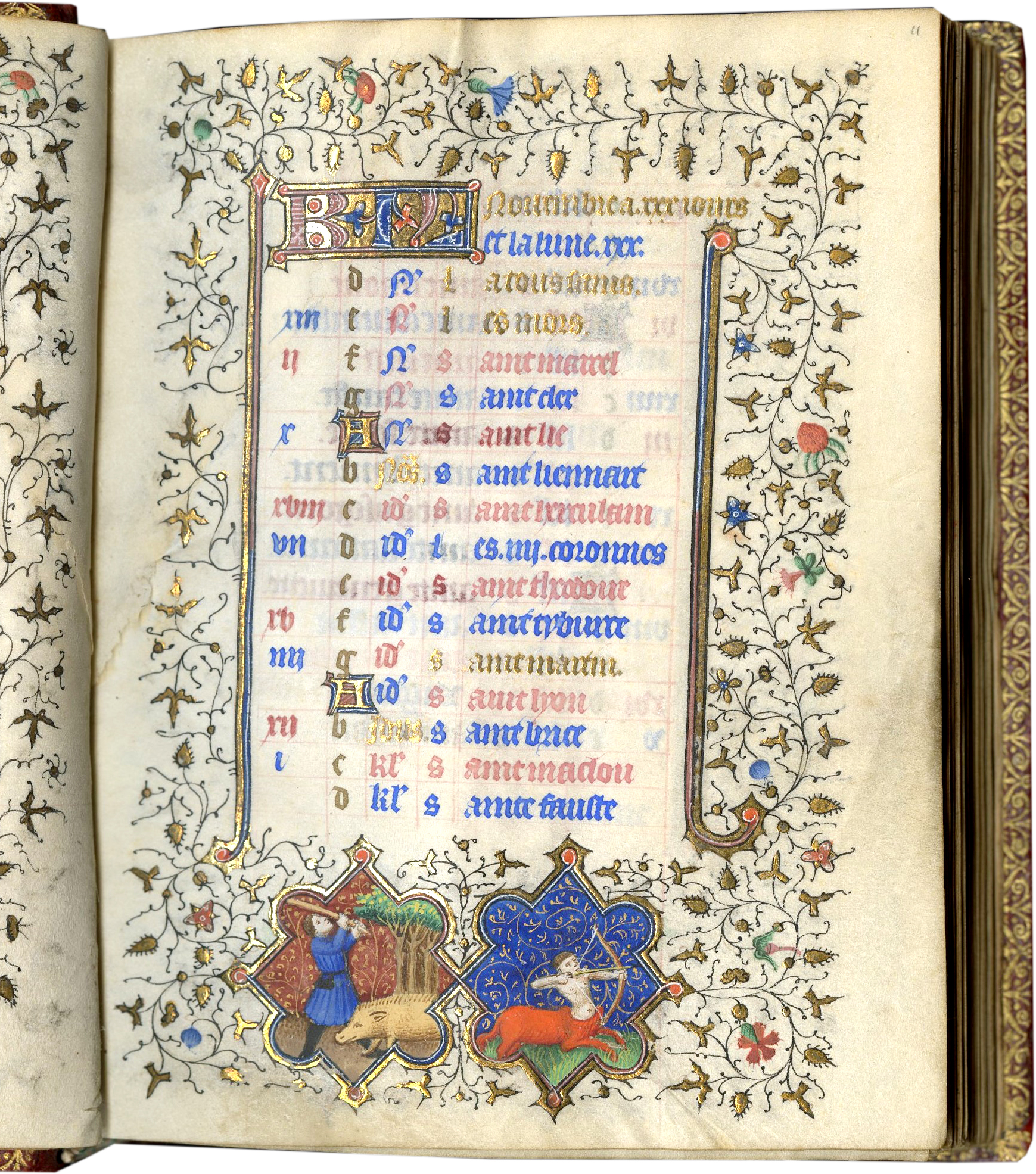
Les Enluminures, BOH 213, The Hours of Le Goux de La Berchère (Use of Paris), France, Paris, c. 1420, f.11
This is a lavish manuscript; thus all special “red letter” days are instead written in gold with other, lesser or “black letter” days written in alternating blue and red. Letters (running from A through G) and Roman numbers (from I to XIX) appear to the left of the list of saints’ days: the Dominical Letters help finding Sundays and all the other days of the week throughout the year (each year this Sunday Letter changed, moving backward); the Golden Numbers indicate the appearances of new moons and full moons throughout the year (the latter by counting ahead fourteen days). This esoteric information was extremely important to the medieval Christian, since it helped determine the date of Easter, the Church’s most important feast, in any given year.
This fabulous November calendar page sparkles with gold all over. The margins are filled with gold vine leaves and dots, and the letters and frames are outlined with gold. November was spent in the forest by most medieval people. Peasants would thrash and hit oak trees or throw sticks into their branches to harvest acorns as food for their pigs. The two cusped quatrefoils in our manuscript contain an image of a Man knocking acorns from trees to feed pigs and the other a depiction of Sagittarius. Some illustrations for the labor of this month show the slaughtering of a fattened pig, but generally, we see depictions of acorn thrashing, as we see here. In this vignette the man is accompanied by a happy pig with his nose to the acorns on the ground.
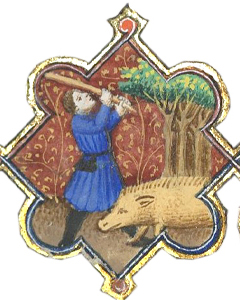
Les Enluminures, BOH 213, The Hours of Le Goux de La Berchère (Use of Paris), France, Paris, c. 1420 , f.11 (detail).
In the following folio, this pig is slaughtered for the December labor. The pairing of a happy, prancing white Capricorn with an unknowing, happily fattened pig whose owner ominously raises an axe behind the unknowing animal might seem disconcerting to modern viewers. But as we have just discussed, medieval time was cyclical. The killing of the pig ensured that life continued through the winter. Time began again with the new year and new pigs were born and raised. This is not a dark ending to the calendar, but a fitting rebirth, a return to the beginning of the cycle.
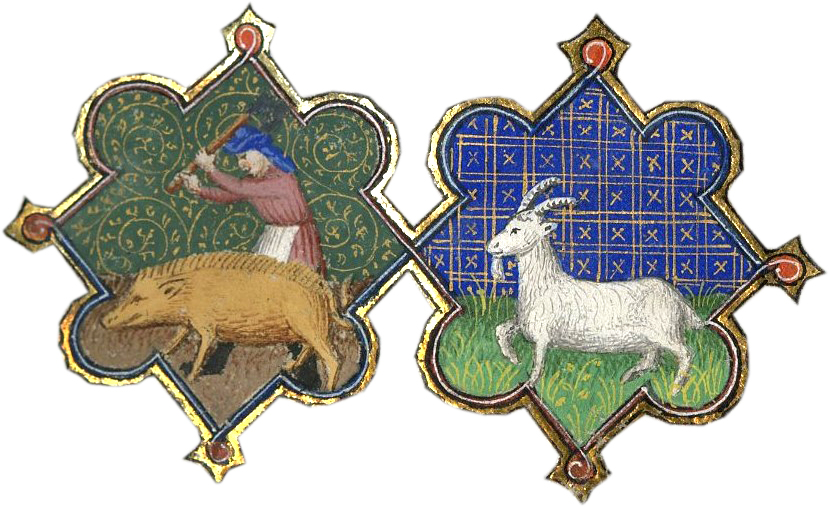
Les Enluminures, BOH 213, The Hours of Le Goux de La Berchère (Use of Paris), France, Paris, c. 1420, f.12 (details)
Pigs were excellent coworkers for medieval farmers because they could subsist off almost anything and they were extremely smart. Medieval people generally would not eat acorns, but these became free sources of food for pigs, essentially converting these useless, bothersome acorns into desirable winter bacon. Pork was available and eaten across all classes and in most areas of Europe with the exception of very arid geographies like the Iberian peninsula. Thus, the pig became a universal symbol of labor, associated with the dawning of winter days across a wide swath of geography and culture.
To the right of this labor on the November page, the cusped quatrefoil contains a hybrid figure: a pale half-man, half bright red horse who leaps across the grassy green and blue space with a drawn bow and arrow pointing toward the edge of the page. This is Sagittarius, the centaur archer. Greek mythology associates Sagittarius with the centaur Chiron, who mentored Achilles in archery, an association that maintained even into the medieval period. Sagittarius was also thought to be a learned healer. This zodiac sign was sometimes simply known as the Archer and could be represented by only the symbol of a bow and arrow. In the medieval period however, this zodiac was almost always represented in manuscript illumination as a centaur, linking time, mythology, animals, medicine, monsters, and the cycle of life.
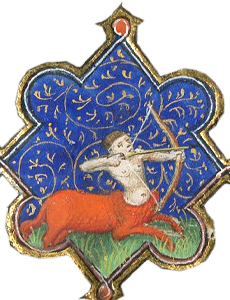
Les Enluminures, BOH 213, The Hours of Le Goux de La Berchère (Use of Paris), France, Paris, c. 1420 , f.11 (detail).
As we enter this new year, I find myself reconsidering time: the past, present, and future. Although we have re-entered standard time here in New York and evening looms far too quickly on the afternoon, it seems more and more important to consider other ways of thinking about and conceiving of our connection with time. Exploring the pages of medieval books of hours is one wonderful method, not of passing time, but of engaging with an illuminating conception of time as a cyclical, returning event.
You can now receive periodic blog post updates by submitting your email up above in “Follow Us.” Make sure to follow us also on Instagram (@lesenluminures), Facebook (Les Enluminures) and at our Twitter (@LesEnluminures)!


